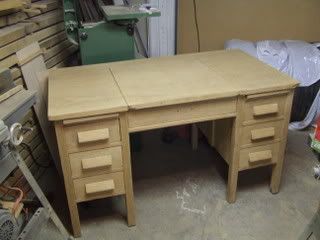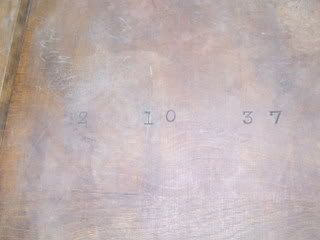Daniel Grant
Member
- Messages
- 3
- Location
- Nova Scotia
Hello everyone, this is my first post here after joining a few weeks ago, so this is my introduction as well. I'm a university graduate student in Nova Scotia, and I've been woodworking since I was a kid, doing everything from building a titanic deck chair replica to carving folk-art butlers.
My latest "project" has actually been more of a restoration, as you can see from the photos below. It's the desk I've sat at for over two years at school, and I decided I couldn't part with it when they replaced the furniture about a month ago. It's actually an old typewriter desk, thought the typewriter tray has been removed and the top fixed with screws, and I had only figured out what all the extra hardware and the cutout in the top were for when I got it home and started taking out screws.


There's a number on the bottom of the desktop, shown below - "2 10 37". I've been entertaining the notion that this is a date, and the desk might actually be 72 years old (as of two days ago), but I only know for certain that it's at least 50 years old, as I found a crumbling letter stuck in the back of one of the drawer runners dated 1961. According to the plaque on the inside of a drawer, it was made by the "Office Specialty Manufacturing Company" in Newmarket, Ontario.

As you can see, it was in an awfully rough condition, and while I've managed to scrap off the old finish, the edge of the desktop is still in poor condition, and since it's not solid oak (the core is some sort of softwood), I was hoping to replace the edge with some oak trim.
The problem I now face is matching the colour, as the desk has a much more yellowish colour than the only oak I have sitting around in the shop, so I'm not sure if I can add the trim without damaging the aesthetics. Should I try to match the trim to the base colour of the unfinished desk, or stain them both to some other darker colour to hide the difference? I can't easily remove the top to work on it, as there's no visible brackets or cleats that hold it in place.
I don't have a huge amount of time to spend playing with this, as I'm finishing a thesis and moving to another province at the end of the month, so any recommendations would be greatly appreciated! (Any educated opinions regarding the age would be helpful as well.)
Regards,
Daniel
My latest "project" has actually been more of a restoration, as you can see from the photos below. It's the desk I've sat at for over two years at school, and I decided I couldn't part with it when they replaced the furniture about a month ago. It's actually an old typewriter desk, thought the typewriter tray has been removed and the top fixed with screws, and I had only figured out what all the extra hardware and the cutout in the top were for when I got it home and started taking out screws.


There's a number on the bottom of the desktop, shown below - "2 10 37". I've been entertaining the notion that this is a date, and the desk might actually be 72 years old (as of two days ago), but I only know for certain that it's at least 50 years old, as I found a crumbling letter stuck in the back of one of the drawer runners dated 1961. According to the plaque on the inside of a drawer, it was made by the "Office Specialty Manufacturing Company" in Newmarket, Ontario.

As you can see, it was in an awfully rough condition, and while I've managed to scrap off the old finish, the edge of the desktop is still in poor condition, and since it's not solid oak (the core is some sort of softwood), I was hoping to replace the edge with some oak trim.
The problem I now face is matching the colour, as the desk has a much more yellowish colour than the only oak I have sitting around in the shop, so I'm not sure if I can add the trim without damaging the aesthetics. Should I try to match the trim to the base colour of the unfinished desk, or stain them both to some other darker colour to hide the difference? I can't easily remove the top to work on it, as there's no visible brackets or cleats that hold it in place.
I don't have a huge amount of time to spend playing with this, as I'm finishing a thesis and moving to another province at the end of the month, so any recommendations would be greatly appreciated! (Any educated opinions regarding the age would be helpful as well.)
Regards,
Daniel
Last edited:

